It looks like you're using an Ad Blocker.
Please white-list or disable AboveTopSecret.com in your ad-blocking tool.
Thank you.
Some features of ATS will be disabled while you continue to use an ad-blocker.
share:
reply to post by drivers1492
It's an Elamite stoneware vase from Jiroft around 5.000 years old, featuring bovines and a fish.
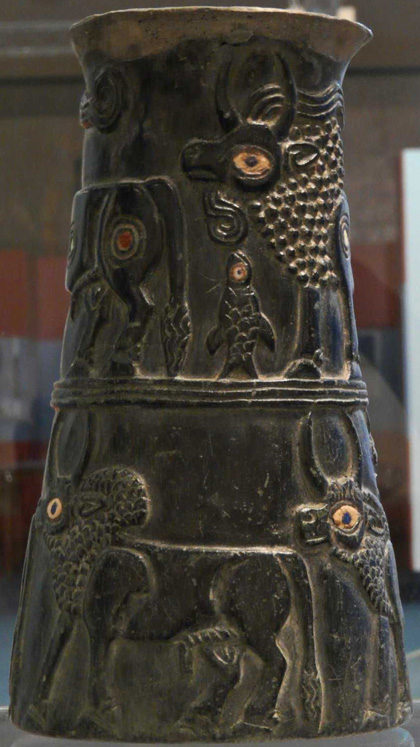
reply to post by BlueMule
That is interesting to note thanks
reply to post by MystikMushroom
But i bet you didn't believe it had anything too do with little people using it as a boat either...
It's an Elamite stoneware vase from Jiroft around 5.000 years old, featuring bovines and a fish.

reply to post by BlueMule
That is interesting to note thanks
reply to post by MystikMushroom
But i bet you didn't believe it had anything too do with little people using it as a boat either...
edit on Kpm13113vAmerica/ChicagoTuesday1431
by Kantzveldt because: (no reason given)
reply to post by Kantzveldt
Nice. Sorry I must have counted wrong the pic I was referring to was right below this one. Looks like carved brick laying in the ground.
Nice. Sorry I must have counted wrong the pic I was referring to was right below this one. Looks like carved brick laying in the ground.
reply to post by drivers1492
Yes that's a foundation brick containg the seven sages/Apkallu, paper on the tradition here
Sometimes they are winged rather than wearing fish costume
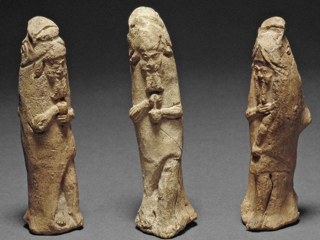
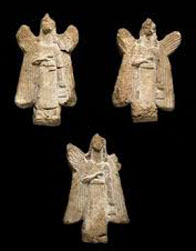
Yes that's a foundation brick containg the seven sages/Apkallu, paper on the tradition here
Sometimes they are winged rather than wearing fish costume


edit on Kpm13113vAmerica/ChicagoTuesday1431 by Kantzveldt because: (no reason given)
For once in a long time, amazed, to look at something that I've never seen before or heard of. Thanks for sharing the images and information.
I was thinking why would a primitive mind look to a spaceship and sculpt it as a boat? I would associate it to a bird flying, not something dwelling in the water. Just thinking about that because of the winged disks from other cultures.
I was thinking why would a primitive mind look to a spaceship and sculpt it as a boat? I would associate it to a bird flying, not something dwelling in the water. Just thinking about that because of the winged disks from other cultures.
Kantzveldt
Yes as i said fine for this piece at 3,000 Bc, well within the era of Taurus rising at the Spring equinox and Leo at the summer solstice, as i tend to consider the greater tradition as dating back to the start of the Neolitihic period that would have seen Taurus rising at the Winter solstice and Leo at the spring equinox, a far better basic premise for foundation, in terms of the solar year and a pale Moon Princess arriving to marry the Sun, associate with the first full moon on the fifteenth day, but times move on...that would posit the figurine tradition as begining with the man from Urfa
I realise the thread was just about artistic styles, hence the wide, generalised sweep, and well of course times move on, but the point being, Neolithic = Farming, hence 'time for planting'...it's all the same, esoterically, which was the only matter I was addressing. Variations depend on the locality and methods employed, again, ALL the symbology is straightforward in that respect also. The only confusion that arises is when one set of people conquer another and merge their mythology evolved elsewhere under different farming conditions, with that of the locals. But that is also when empires begin to crumble...usually through lack of food, let alone trading surplus.
reply to post by KilgoreTrout
It is very much about viticulture and the grain harvest, wine/blood and bread/body, the importance i placed on the 15th day of the first month as the day of fate, a whole world of complexities here
reply to post by m3lh4d0
In older tradition the night sky was understood as the waters above, it was natural to travel through it by boat.
It is very much about viticulture and the grain harvest, wine/blood and bread/body, the importance i placed on the 15th day of the first month as the day of fate, a whole world of complexities here
reply to post by m3lh4d0
In older tradition the night sky was understood as the waters above, it was natural to travel through it by boat.
edit on Kpm13113vAmerica/ChicagoTuesday1431 by Kantzveldt because: (no reason given)
Kantzveldt
reply to post by KilgoreTrout
It is very much about viticulture and the grain harvest, wine/blood and bread/body, the importance i placed on the 15th day of the first month as the day of fate, a whole world of complexities here
I read the paper that sourced the information for that thread from when you linked the quote from it in TheGuts Electromagnetic thread, but I didn't see the connection to the conclusions that you drew in that thread, anymore than I do here. Perhaps you can explain the 'whole world of complexities' that you are referring to, for clarity's sake, here, in your own words?
Oannes
reply to post by drivers1492
No special angles are needed. At night, at the right time, the Pleiades are directly overhead.
At night, at the right time, a whole lot of stars are directly overhead--not just the Pleiades, so the question becomes, why pick on the Pleiades? Why not call out any of the dozens of other stars and constellations that take their turn being directly overhead? Well, because it doesn't fit the theory.
I can well understand the solid research that shows the ancients were well-versed in astronomy and used celestial issues in their religions and mythology. Another example is the three pyramids representing the stars in Orion's belt. They are of three sizes that correspond with the magnitude of those three stars, and running the celestial clock backwards yields the constellation Orion rising at a time corresponding to roughly 12,000 B.C., therefore some conclude that the pyramids, and especially the sphinx, were constructed about that time.
Whether my dates are precise or not is not important. The idea that the ancients used celestial events to represent issue son Earth is, but nobody ever claimed that because of this, somehow we came from the stars in Orion's belt. In a similar manner, the idea that the Pleiades feature in ancient legends does not mean we "came from there."
That logical leap is not substantiated and not supported by anything else.
reply to post by KilgoreTrout
I can only touch upon the general principles involved, which are the passing over from darkness to light, as represented by the first full moon of the New Year, the year thus properly established, the principle of sacrifice for the greater collective good.
Examples of usage are the one i have highlighted here, were a God is sacrificed whose nature is that of 'intelligence' in order to illuminate mankind, giving his body and his blood, the key number being fifteen, the seven male and female created from this and the God himself.
An example of usage is the Hebrew Passover, the fourteenth day of the first month, and the departure from the given darkness of Egypt on the subsequent day, a collective body enabled to survive the striking down of the first born through partaking of the sacrificial body and blood of the lamb without blemish, this seen again in Christianity at the last supper on the day following the Passover, again the passing from darkness to light, the collective Eucharist of the sacrificial victim.
Again the Feast of Wagy with regards to the cult of Osiris, commencing on the fifteenth day of the first month, a three day festival partaking of his substance in order to have a share in his resurrection into the light from death.
It wasn't so important when the New Year was seen to begin, the tradition of the numbering seems to have had priority, the sacrificial victim is associate with the full moon.
I can only touch upon the general principles involved, which are the passing over from darkness to light, as represented by the first full moon of the New Year, the year thus properly established, the principle of sacrifice for the greater collective good.
Examples of usage are the one i have highlighted here, were a God is sacrificed whose nature is that of 'intelligence' in order to illuminate mankind, giving his body and his blood, the key number being fifteen, the seven male and female created from this and the God himself.
An example of usage is the Hebrew Passover, the fourteenth day of the first month, and the departure from the given darkness of Egypt on the subsequent day, a collective body enabled to survive the striking down of the first born through partaking of the sacrificial body and blood of the lamb without blemish, this seen again in Christianity at the last supper on the day following the Passover, again the passing from darkness to light, the collective Eucharist of the sacrificial victim.
Again the Feast of Wagy with regards to the cult of Osiris, commencing on the fifteenth day of the first month, a three day festival partaking of his substance in order to have a share in his resurrection into the light from death.
It wasn't so important when the New Year was seen to begin, the tradition of the numbering seems to have had priority, the sacrificial victim is associate with the full moon.
edit on Kpm13113vAmerica/ChicagoTuesday1431 by Kantzveldt because: (no reason given)
The ship of heaven looks to be a cross between a Viking long-ship and a Conestoga wagon. What better way to traverse the splash of bull semen that
is the milky-way... or a prairie with rivers?
And what was that legend... rather modern theorizing, that fish-folk from space walked out of the Persian Gulf and bestowed humans with civilization?
Neat subject again, KV... you have a nose for oooold news, you do.
Edit" Mass Effect ... fav character, heh. What's under the mask...?
And what was that legend... rather modern theorizing, that fish-folk from space walked out of the Persian Gulf and bestowed humans with civilization?
Neat subject again, KV... you have a nose for oooold news, you do.
Edit" Mass Effect ... fav character, heh. What's under the mask...?
edit on 1/14/2014 by Baddogma because: (no reason given)
Some more information on fish and star icons connected to language in Ancient Cultures.
The Indus Script
The Indus Script
8. Fish and the God of Waters
If the 'fish' pictograms of the Indus script generally meant 'star', why was the meaning 'star' not expressed directly with a 'star' pictogram as in the ancient Near East? Why did the Harappans in a more complicated way use a 'fish' pictogram and the rebus principle? One answer could be that though this method may appear more complicated to us, it probably did not appear so to the Indus scribes, in whose language the same word denoted both 'fish' and 'star'. But there is also another satisfactory answer to this question.
9. An "Early Harappan" polychrome pot with fish design from Nal, South Baluchistan.
In the Sumerian script, the 'star' pictogram means not only dingir 'god' but also anu 'sky', and it seems that the 'star' pictogram originally was the exclusive symbol and attribute of the sky-god Anu. As Anu was the leading divinity of the Sumerian pantheon, his symbol started also meaning 'godhead', and then 'god' in general.
The 'fish' pictogram of the Indus script appears to have had a somewhat similar background. The reason why 'fish' and not 'star' was selected to represent the concept of 'god' seems to be that in the Early Harappan religion the fish occupied a central position: fish is one of the most popular motifs of the Early Harappan painted pottery (Fig. 9). As the aquatic animal par excellence, it appears to symbolize the God of Waters. The importance of this deity in the Harappan pantheon is proved by his popularity in the Harappan iconography.
reply to post by Baddogma
The tales of fishy Oannes emerging from the deep and teaching people a thing or two followed by further fish-human monsters are from the classical period, a continuation of the Apkallu tradition, all true of course.
I've never played Mass Effect, i just have a thing about aliens and masks and the picture was posted in this thread here.
reply to post by theabsolutetruth
That's good thanks, similar to the Babylonian then were the Pleiades could simply be referred to as Mul Mul, star of stars, but the Indus valley correlations of the fish/star to Divinity and the waters of the Heavens make things a lot clearer, a fish of fishes
The tales of fishy Oannes emerging from the deep and teaching people a thing or two followed by further fish-human monsters are from the classical period, a continuation of the Apkallu tradition, all true of course.
I've never played Mass Effect, i just have a thing about aliens and masks and the picture was posted in this thread here.
reply to post by theabsolutetruth
That's good thanks, similar to the Babylonian then were the Pleiades could simply be referred to as Mul Mul, star of stars, but the Indus valley correlations of the fish/star to Divinity and the waters of the Heavens make things a lot clearer, a fish of fishes
edit on
Kam13114vAmerica/ChicagoWednesday1531 by Kantzveldt because: (no reason given)
reply to post by Kantzveldt
That helps to clarify things a lot, thanks. You have to bear in mind that the Neolithic religious structure is built up the preceding 'natural' fertility religion based on environmental and personal observation. Right from the off-set, observation is humanities key skill, combined with our extraordinary imagination. Intelligence is linked with the Moon and the earliest fertility cults associate the Moon with feminine intelligence, and blood with the Moon. The 14/15 symbology is tied in to that, and was evolved by the farming communities in planning the planting and harvest calendar, and it makes some sense to do so. The year was divided, in the farming sense, along 13 months of 28 days. And in the human sense, which would then be applied to the Earth Mother by abstraction, the 14th/15th day of optimum fertility when the new life cycle begins and the egg is released. Bear in mind that many peoples, such as the Celts, marked the night as the start of the day, the Moon being predominant in measurement. And with that in mind, that all words regarding measure, including mathematics, derive from the feminine 'Me' or 'Ma'.
That helps to clarify things a lot, thanks. You have to bear in mind that the Neolithic religious structure is built up the preceding 'natural' fertility religion based on environmental and personal observation. Right from the off-set, observation is humanities key skill, combined with our extraordinary imagination. Intelligence is linked with the Moon and the earliest fertility cults associate the Moon with feminine intelligence, and blood with the Moon. The 14/15 symbology is tied in to that, and was evolved by the farming communities in planning the planting and harvest calendar, and it makes some sense to do so. The year was divided, in the farming sense, along 13 months of 28 days. And in the human sense, which would then be applied to the Earth Mother by abstraction, the 14th/15th day of optimum fertility when the new life cycle begins and the egg is released. Bear in mind that many peoples, such as the Celts, marked the night as the start of the day, the Moon being predominant in measurement. And with that in mind, that all words regarding measure, including mathematics, derive from the feminine 'Me' or 'Ma'.
After reading your OP I found it interesting to read this page from a new angle:
en.wikipedia.org...
en.wikipedia.org...
reply to post by KilgoreTrout
Yes there's no doubt that the basic principle of the fifteenth day as the day of fate is the question of whether it shall be life or death, a window of opportunity to either fertilize the egg or for inevitable demise to ensue, but that is being used in an highly extended manner in the mysteries of Osiris and Christianity, were one is acting upon the opportunity of the full moon as it were.
In the Atra Husis narrative it would be the fourteen womb Goddesses that were seen as synchronized with the fifteenth day in order to receive the prepared insemination, there was method in their madness.
Of course then on the fifteenth day that is when Inanna as a facilitator of pro-creation really needs to get her act together and hence her association with it, and her arrival from the Pleiades with her fourteen crew members, the fertility rite aspects are there, but in the sense of cosmic fertilization
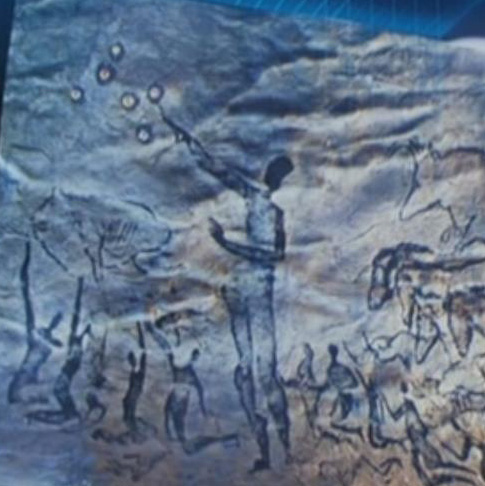
Yes there's no doubt that the basic principle of the fifteenth day as the day of fate is the question of whether it shall be life or death, a window of opportunity to either fertilize the egg or for inevitable demise to ensue, but that is being used in an highly extended manner in the mysteries of Osiris and Christianity, were one is acting upon the opportunity of the full moon as it were.
In the Atra Husis narrative it would be the fourteen womb Goddesses that were seen as synchronized with the fifteenth day in order to receive the prepared insemination, there was method in their madness.
Of course then on the fifteenth day that is when Inanna as a facilitator of pro-creation really needs to get her act together and hence her association with it, and her arrival from the Pleiades with her fourteen crew members, the fertility rite aspects are there, but in the sense of cosmic fertilization

edit on Kam13114vAmerica/ChicagoWednesday1531 by Kantzveldt because: (no reason given)
The "Ship of Heaven" does, indeed, look like some sort of craft, but why does this translate to some sort of space ship? Indeed, it looks remarkably
like the power craft that shuttle visitors around in Venice, Italy. You have exactly the same canopy structure at the rear of the "boat" for the
passengers and a stylized representation of a creature at the bow (much like a Viking ship). Add an outboard, or earlier, some oars, and you've got
yourself a Venice tourist craft. I just happened to see them in the BBC series "Lovecraft" a few days ago.
I'm not surprised.
The Pleiades, Orion, and Sirius seems to be the most important places when it comes to Gods and Religions.
The Pleiades, Orion, and Sirius seems to be the most important places when it comes to Gods and Religions.
reply to post by drivers1492
Last night I closed my eyes and pointed my finger straight up into the air. It pointed directly at something and a moment later it was pointing directly at something else. To say that anything points directly at the Pleiades as some kind of proof of indication of something more is just ludicrous. Your reply was much more polite than I could have managed.
Last night I closed my eyes and pointed my finger straight up into the air. It pointed directly at something and a moment later it was pointing directly at something else. To say that anything points directly at the Pleiades as some kind of proof of indication of something more is just ludicrous. Your reply was much more polite than I could have managed.
Some corresponding astrological / gematria / geometry of the ancients, including the significance of the bull and the Vesica Piscis, profound ancient
geometry.
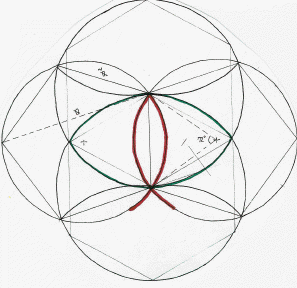
Vesica Piscis
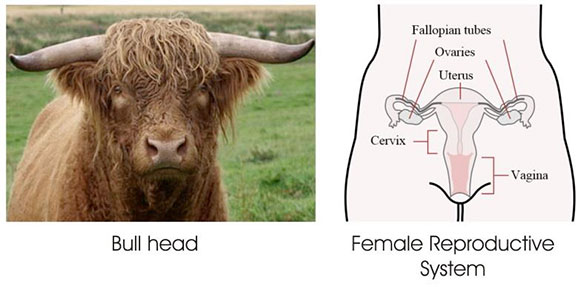

Vesica Piscis
Vesica Pisces
The Vesica Pisces is easily one of the most profound geometrical images of ancient and modern times. (5/31/05) It is, for example, considered to be an integral part of the Ark of the Covenant, as described and shown figuratively by ka-gold's version of the Vesica Pisces. The latter article, in fact, ties in rather nicely with the so-called Hourglass Nebula described at the end of this Halexandrian webpage.
Essentially the intersection of two, overlapping spheres, the Vesica Pisces (including the interior portion of it, and/or the more common two dimensional version) represents, among other things:
1) The joining of God and Goddess to create an offspring,
2) A symbol for Jesus Christ,
3) In art a pointed oval used as an aureole in medieval sculpture and painting,
4) The vagina of the female goddess,
5) The basic motif in the Flower of Life,
6) An overlay of the Tree of Life,
7) The formative power of polygons,
8) A geometrical description of square roots and harmonic proportions, and/or
7) A source of immense power and energy,
1) In the earliest traditions, the supreme being was represented by a sphere, the symbol of a being with no beginning and no end, continually existing, perfectly formed and profoundly symmetrical. The addition of a second sphere represented the expansion of unity into the duality of male and female, god and goddess. By overlapping, the two spheres, the god and goddess created a divine offspring. The Vesica Pisces motif (and its derivatives, the Flower of Life, Tree of Life, and fundamentals of geometry) has a history of thousands of years and easily predates virtually all major religions of the current era.
2) The son or daughter of the god and goddess is associated with the overlapping of the spheres -- the resulting three dimensional figure somewhat like an American football. [Sorry about that!] In the case of Jesus Christ, the two dimensional figure has also served as a symbol for the miracle of the fishes. (The “tail” also served to more easily identify the source of the plane figure.) There is also conveyed the spiritual power originating from the interior of this symbol.
3) Virtually every medieval church in Europe uses as a standard motif, the Vesica Pisces in two dimensions. The fact many of these churches were dedicated to the Virgin Mary or to Mary Madagalene (aka the goddess) is simply part of the understanding. Several of the churches in northern France are even located in such a manner that their points of light recreate the “lights” of the constellation Virgo. In Glastonbury, England, the site normally attributed to Avalon (the island of the Goddess), is also where the Chapel of St. Mary is located -- the latter which is apparently patterned with the use of the Vesica Pisces.
4) The goddess of any and all religions which recognize her power and significance invariably use the Vesica Pisces to identify her. From the overlapping pools of water and the chalice well cover in the goddess’s garden in Glastonbury (aka Avalon) to any number of representations of the Tree of Life, the goddess and her ability to create and birth life are celebrated.
5) Drunvalo Melchizedek, in his Flower of Life symbolism, uses the Vesica Pisces as well, and considers it the geometric image through which light was created.
6) The Tree of Life is shown in one of its many representations as the primary graphic of the home page of this website, and includes the Vesica Pisces (and Flower of Life) quite deliberately. The ease with which the patterns fit make the inclusion a virtual automatic.
7) Robert Lawlor, in one of the best books available on Sacred Geometry [Thames and Hudson, 1982] notes that the Ö3 contained within the Vesica Pisces is “the formative power giving rise to the polygonal ‘world’.”
8) In Mark Percy's Appendix to the unique book, Two Thirds, Aulis Publishers, London, 1993] the square roots of 2, 3, and 5 (three of the first digits in the Fibonacci Numbers) can be geometrically calculated. This is just an inkling of the possibilities.
9) In 1996, a Crop Circle in the shape of the Vesica Pisces appeared in England. Anyone stepping into the inner portion of the two circles’ intersection could feel a sudden rush of energy. More dramatically, is the Hubble Space Telescope photo of the ineptly named Hourglass Nebula , in the center of which is a dramatic, colorful object, supposedly the remnants of a dying star (one about the size of our Sun). The green spot, in fact, is larger than the size of our solar system! (*) The photograph is so dramatic, in fact, that it has appeared on the cover of National Geographic [April 1997]. (**) Clearly, there is power within the Vesica Pisces!

GRABBING THE BULL BY THE HORNS
Before we move on to look at the mathematics, symbolism and gematria of this process, let’s first look at the female reproductive system symbolically. It is interesting to note that the shape of a woman’s reproductive area and the head of a bull are strikingly similar in appearance.
Pi3_3There are many references to bull worship throughout religions worldwide. The name El has long been associated with the name of the bull God in many languages (Hebrew, Greek and Egyptian) and is a suffix and prefix found within many names of saints, disciples and divine characters: GabriEL, MichaEL, RaphaEL, SamuEL, AngEL. Bull or calf worship is prevalent in Hindu, Egyptian, Grecian, Minoan, Roman and biblical religious art and architecture, to name but a few. This bull was often depicted with the sphere or egg of creation nestled between its horns.
Pi3_4
Astro-theology, or more widely known as astrology, is the subject of study that laid the foundation for nearly all of the religious mythologies of the world and it is here where we the see the golden calf most prominently referenced, in the constellation Taurus, the Bull.
In ancient religions, star worship was directly related to the universe of man and man was in turn a reflection of the firmament of stars above, an idea known as the anthropocosm. The constellations above were mapped onto the human body below, as man was but a reflection of the creative power of the heavenly spheres and lights of our night sky.
Pi3_5
Considering that the ancients deemed the stars and constellations of our zodiac to be mirroring the temple of man, it is quite pertinent to point out the linguistic similarities of UTERUS and TAURUS as well as OVARIES and ARIES within the female reproductive system. Aries is the Ram constellation and the zodiacal sign that is attributed to
enlightenment, most notably referenced with Jesus Christ being the Lamb of God. The sun rises in the constellation of Aries during spring. It is at this time in which the sun crosses, or passes-over the equator, around Easter, signifying the blooming of a new year and the rebirth of life (ancient Roman calendars began their year in March). Passing Aries on its annual path, the sun then makes its journey through the constellation Taurus, the Bull. It is during this time of year when life is renewed and the earth springs up from the depths and death of winter and the sun makes its long crawl up to the Tropic of Cancer. The correlation we may make to the womb where the human mother gives birth (the ovaries and the uterus) and the season in which the rebirth of life occurs on mother Earth (or the zodiacal signs of Aries and the Taurus) is most fitting. If man is indeed a reflection of the first moment of creation and, as the ancients believed, a reflection of the heavens above as well, these correlations within the words of human anatomy and the stars above should come as no surprise to anyone who is well versed in esoteric or occult lore. Only those with a willingness to consider deeply the nature of such parallels will recognize the true ingeniousness of the ancients who once walked this Earth. On the zodiacal makeup of man the constellation Aries was assigned to the head and Taurus was assigned to the neck and isn’t it quite interesting that the first things that emerge from the womb or vagina in labor is the head and neck of the baby.
new topics
-
How To Spot Fake U.F.O. Photos
Aliens and UFOs: 2 hours ago -
Scary video of face in an abandoned house
Paranormal Studies: 4 hours ago -
Just Came Across These Unusual Old UFO Pics
Aliens and UFOs: 6 hours ago -
LA Mayor Bass Demanded $49M in Additional LAFD Cuts One Week Before Wildfires
Mainstream News: 8 hours ago -
Sepultura - Territory - With New Drummer Greyson Nekrutman
Music: 9 hours ago -
Carry On!
Short Stories: 9 hours ago
top topics
-
This should be plastered all over the airwaves
Mainstream News: 15 hours ago, 24 flags -
LA Mayor Bass Demanded $49M in Additional LAFD Cuts One Week Before Wildfires
Mainstream News: 8 hours ago, 17 flags -
Archbisop Vigano Warns of Deep State and Deep Church
New World Order: 17 hours ago, 16 flags -
Oh, Good Gosh. “Kremlin Warns Stay Away from Greenland.”
World War Three: 17 hours ago, 12 flags -
Just Came Across These Unusual Old UFO Pics
Aliens and UFOs: 6 hours ago, 7 flags -
Scary video of face in an abandoned house
Paranormal Studies: 4 hours ago, 5 flags -
How To Spot Fake U.F.O. Photos
Aliens and UFOs: 2 hours ago, 4 flags -
Carry On!
Short Stories: 9 hours ago, 3 flags -
Sepultura - Territory - With New Drummer Greyson Nekrutman
Music: 9 hours ago, 2 flags
active topics
-
Old School Punk
Music • 566 • : underpass61 -
-@TH3WH17ERABB17- -Q- ---TIME TO SHOW THE WORLD--- -Part- --44--
Dissecting Disinformation • 3987 • : duncanagain -
To become president, Zelensky had to learn Ukrainian
Political Conspiracies • 44 • : SteamyAmerican -
Los Angeles brush fires latest: 2 blazes threaten structures, prompt evacuations
Mainstream News • 383 • : WeMustCare -
Judge rules president-elect Donald Trump must be sentenced in 'hush money' trial
US Political Madness • 120 • : Vermilion -
This should be plastered all over the airwaves
Mainstream News • 55 • : Astrocometus -
Oh, Good Gosh. “Kremlin Warns Stay Away from Greenland.”
World War Three • 32 • : SteamyAmerican -
Candidate TRUMP Now Has Crazy Judge JUAN MERCHAN After Him - The Stormy Daniels Hush-Money Case.
Political Conspiracies • 2190 • : WeMustCare -
Iran Sympathizers in Biden Admin Leak Intelligence on Israel Attack Plans
Mainstream News • 86 • : WeMustCare -
How To Spot Fake U.F.O. Photos
Aliens and UFOs • 1 • : nugget1
